Head to Negombo for a gastronomic adventure!
Negombo’s Lewis Place has the tentative swagger of a teenager who has finally come of age – a teenager in the throes of change, wondering where to fit in.
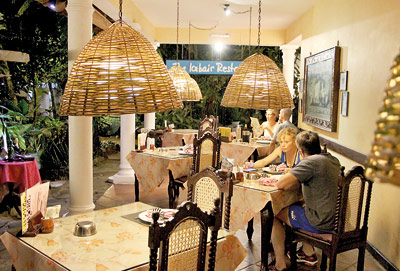
The Ice Bair: A tucked away haven
With its proximity to Colombo (38 km) and the Katunayake airport (8km), Negombo tends to be a transit hub for most tourists and is either the first or last stop during their stay in Sri Lanka.
While Negombo’s beaches pale in comparison to its Southern and East Coast counterparts (I’m sorry Negombo, but it’s true), its fish market, beautifully ornate churches, lagoon, water sports and culinary offerings have their own charm and warrant more exploring than a mere pit stop.
This week, Eat Street heads to Lewis Place in Ethukala, Negombo, to explore its growing food scene.Once a sleepy stretch of road, punctuated by the occasional hotel and restaurant, Lewis Place is now packed to the seams with hotels, guesthouses, souvenir and craft stores, jewellery shops, restaurants, cafes and pubs and is still seemingly growing.
While old food favourites such as Rodeo and Lords restaurant have withstood the sands of time, new restaurants keep mushrooming intermittently – some fading away while the stronger survive. The atmosphere is laid back but there’s a Darwinian business survival of the fittest here.
From pancake houses, Swiss restaurants and five star dining to Japanese sushi bars (complete with sushi conveyor belt) and with brands such as Coffee Bean also joining the party, Ethukala seems to have reached its gastronomic peak.
New hotels spanning varying budgets loom over Lewis Place while homeowners with a room to spare and a keenness to tap into the tourist numbers, announce rooms to let on handwritten signboards, adding the final flourishes to the crammed road.
Dolce Vita
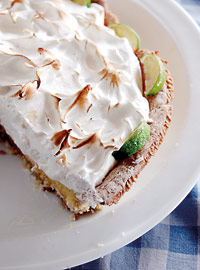
Dolce Vita: Savour the charm of an unpretentious coffee shop
For a quick breakfast, a stop at Dolce Vita will do the trick. The family-run coffee shop and restaurant is a homespun affair with outdoor seating leading out to the beach and a mixed bag of prints and paintings adorning its interiors. The food is simple – the coffee shop’s charm is in its unpretentious atmosphere.
In the mornings, freshly baked croissants and savoury pastries are laid out in the display cases while homemade multi seed bread, baguettes and bread rolls are arranged out on the counter.
Brother and sister, Carlton and Tania Fernando explain that Dolce Vita started out in 2006 to fill a void in Negombo – a space for people to simply unwind on the weekend by the beach with a cup of coffee. Tania smilingly adds that Dolce Vita’s name (‘The Sweet Life’ in Italian) was derived from Federico Fellini’s acclaimed comedy-drama in the sixties.
Initially serving only coffee, the coffee shop expanded its food offerings and now has an assortment of cakes and pies as well as mains, salads and appetizers and a variety of alcoholic and non-alcoholic beverages.
The coffee shop also serves up homemade ice creams and sorbets and sells homemade pickles and jams (from starfruit to anoda and passionfruit) made by a Negombo based couple.
For a light breakfast, try the cheese croissant (a little heavier than the standard croissant but filling) and a cappuccino with a slice of pie on the side for some early morning sugar indulgence.
The ambience gets livelier in the evenings with a quiz night on Tuesdays and live music on Fridays, making for a relaxed and animated dining atmosphere by the beach.
The Ice Bair Restaurant
The Ice Bair Restaurant is a part of the Ice Bear Beach Guest house and defies the formulaic layout of most Negombo restaurants.
You’d be forgiven for missing it (the banner of a polar bear perched on an iceberg outside its premises piques interest but isn’t very inviting) but do wander in – the Ice Bair is a little haven tucked away in Lewis Place – the kind of secluded place you would go with a book to wilfully lose track of time.
There’s a sense of tamed wildness to the garden which is separated by an arched doorway that leads a path to the beach. Passion fruit creepers, coconut trees, cacti, bamboo, ferns compete for space with jungle flowers, hibiscus, banana trees, gotukola and a host of other foliage.
Thin strips of coloured ribbon are tied to the branches, fluttering madly when a breeze billows through the garden, and milk-white seashells are studded at the base of trees – I’m reminded of a book in the Anne of Green Gables series where seashells adorn Anne’s flower beds.
An old dog (Lisa) plods up slowly, greeting visitors with the gentlest of welcomes, while a hen (Laura the fourth, I’m, told) disgruntledly scuttles into the verdant foliage.
The Ice Bear Guest House was initially built as a retirement home for proprietor G. A. Haisch (“They call me Gerry. They baptised me with this name and I can’t wash it away”) who accidentally came to Sri Lanka and knew immediately this was where he’d like to spend his twilight years.
Gerry, who retired at the tender age of 53, realised two things during his early retirement. The first was that he was not wired for retirement and the second, the house was far too big to house one person.
And so, the Ice Bear Guest House came into being. Gerry, now 75, explains that the privacy and seclusion the café affords is a big draw for its visitors.
At 7 p.m. every day at the Ice Bair Restaurant, a bell is rung seven times and music immediately fills the restaurant, setting the stage for dinner.
There’s a delightful disorder to the music – on some days it’s Jazz or Classical and on others, perhaps Elvis Presley or Rukmani Devi.
The five course ‘Captain’s dinner’ menu is always fixed and needs to be pre-ordered but you can also order a la carte. Perhaps, go before the sun sets though while the restaurant is charming, the mosquitos can be a mood killer.
Rice and curry, assorted snacks, Roeschti and other Swiss fare, special breakfast muesli, seafood mains and an interesting beverage menu complete the café.
Bacco Vino Vino
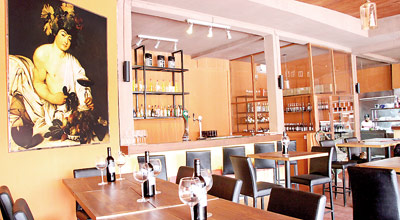
Bacco Vino Vino: Indulge the tastes of Italy
At Bacco Vino Vino, an indolent Bacchus watches over restaurant goers, reclining in a loose white robe with vine leaves and grapes in hair and a goblet of wine in his hand.
A print of Caravaggio’s painting of a young Bacchus is the first thing that catches your eye at the restaurant which is named after the Roman god of agriculture and wine.
Proprietor Roy de Cruz is also the owner of Prego, a popular pizzeria down the road in operation for the past 3 years. Bacco Vino Vino is his latest food venture and is a year old.
For Roy, Italian cuisine’s appeal lies in its simplicity and use of fresh ingredients. With Italian food, Roy explains, you get the all-in-one package from food and wines to dessert and coffee.
Born and bred in Negombo and with over a decades experience in restaurants in Singapore, Roy set about designing an open air restaurant with a warm, casual ambience paired with authentic Italian food and an extensive selection of wines (to be expected of course, when the god of wine is the mascot of the restaurant).
The open air ambience has its merits but can be slightly marred by the bustle and noise on the road during the day and is nicer at night.
The menu covers pizzas (starting at Rs. 990) and familiar Italian dishes such as bruschetta (Rs. 350) homemade gnocchi (starting at Rs. 1,100) and risotto (Rs. 1500) and offers a wine list encompassing Italian, Australian and Chilean wines.
A ravioli which Roy personally whips up – crimped pasta pillows stuffed with a mild spinach and ricotta filling and a porcini mushroom sauce and a drizzle of truffle oil – is perfect for a light bite.
Bacco Vino Vino also offers cheese platters and a selection of cold cuts and Roy is excited about prepping for new seafood additions to the menu in lieu of the season.
Coco Beach
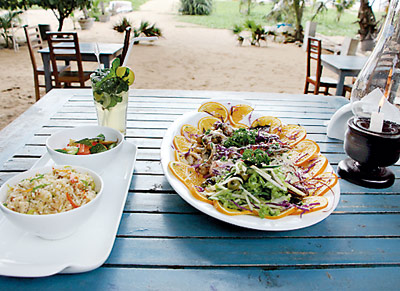
Coco Beach: Seafood all the way
For Sam Wijayapura, Negombo is one of the best places to sample the island’s seafood. “The flavour and the texture [of the seafood] you get from Negombo cannot compete with other places in Sri Lanka,” asserts Sam, looking out to the sea.
Coco Beach, Sam’s restaurant, bar and grill, is a little away from the bustle of Lewis Place and is one of his childhood dreams which has finally reached fruition.
While the pub faces the road, the restaurant’s dining area stretches on to the beach with coconut trees providing a natural canopy to its deck area.
Blue patina tables and Sri Lankan themed paintings of dancers, beaches and boats occupy the wood-brick interiors (a print of Edvard Munch’s Scream being the odd exception).
A few days a week, Sam heads to the evening fish market in Negombo to choose the best seafood for Coco Beach’s kitchens from the fishermen’s catch.
After sifting through the day’s catch, the seafood is taken to Coco Beach for its evening seafood display. Nestled on a bed of ice, restaurant goers pick and weigh their seafood and pair it with their preferred method of preparation and other mains.
A popular venue to rent out for small parties and functions, Coco Beach’s main emphasis is seafood and also serves up the usual fusion fare.
There’s an assortment of sandwiches and burgers (Rs. 530 onwards), variations on pasta, rice and noodles (Rs. 450 and above) as well as a breakfast menu and starters such as oyster platters, baked crab and baby clams.
Jetwing Beach’s Black Coral
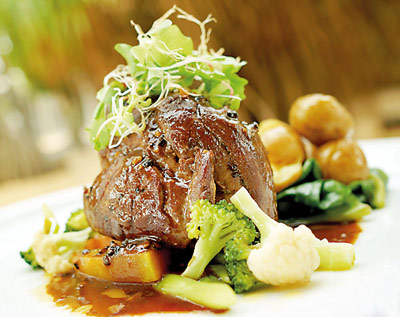
Jetwing Beach’s Black Coral: A touch of luxury on the beach
Meanwhile, Jetwing Beach’s fine dining restaurant, Black Coral, quietly raises the bar and brings the luxury quotient to Lewis Place.
If you’re in the mood to splurge and would like an exclusive fine dining atmosphere or even perhaps a personalized barbeque under the stars for a special occasion, Black Coral would be an interesting spot for dinner.
Like most fine dining establishments, Black Coral eschews sprawling, extensive menus and instead offers a limited, carefully chosen selection of dishes (with halal and vegetarian options marked discreetly).
Executive Chef, Kalanapriya Wickramasinghe and General Manager of Jetwing Beach, Hyacinth Gunawardena explain that that the restaurant’s attraction lies in its reinvention of familiar dishes with unique preparations and element of personalization for diners, when required.
A firm proponent of fresh, locally sourced seafood instead of imported varieties, the hotel sources ingredients such as spinach, beans and gotukala from its organic garden within the premises and taps toddy in its gardens to make thick, authentic coconut treacle.
Black Coral’s strengths lies in the action which goes behind the scenes – playful experimentations with ubiquitous Sri Lankan fruits and ingredients (resulting in homemade ambarella sorbets or wood apple mousse, for instance), unique spice blends and cooking techniques.
The restaurant’s signature dish is the “Meepura issan hindala” – tempered Negombo prawns and herb crusted soled fish served with rice and vegetables (Rs. 2,280) – and serves up culinary heavyweights spanning pan fried roulade of Australian lamb rack with lamb ragout, garlic puree and aubergine gratin (Rs 3,720) tobeach seafood grills (Rs. 2,700) for its main fare.
For the Jetwing group in particular, Negombo has a special place and is threaded into its legacy. Dimitri Cooray, Director at Warwick Gardens, reminiscences about how the first Jetwing Hotel – started by Herbert Cooray, Jetwing’s late chairman – began in Negombo and how the beaches and the locality has metamorphosed over the years, sculpted by tourism and urban changes. “Now Negombo has the whole experience,”smiles Dimitri.


